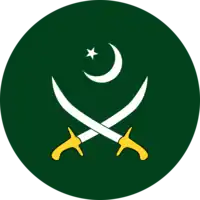National Guard of Pakistan
The National Guard of Pakistan (Urdu: پاسدارانِ ملّیِ پاکستان) is a paramilitary force and one of four reserve components of the Pakistan Army, designed to act as a "second line of defence",[3]:84 together with the Pakistan Army Reserve, the Frontier Corps and the Pakistan Rangers.[2]
| Pakistan National Guard | |
|---|---|
| پاسدارانِ ملّیِ پاکستان | |
 | |
| Founded | 3 January 1948[1] |
| Country | |
| Allegiance | Government of Pakistan (The National Guards Act, 1973) Provincial governments in Pakistan |
| Branch | |
| Type | Reserve component |
| Role | Border control, law enforcement, first responders |
| Size | ~185,000[2]:notes/contents |
| Garrison/HQ | Army GHQ, Rawalpindi |
| Colours | Green and White |
| Anniversaries | Defence Day: September 6 |
| Engagements | Indo-Pakistani wars and conflicts
Global War on Terror Siege of Lal Masjid War in North-West Pakistan Balochistan conflict |
| Website | www |
| Commanders | |
| Chief of Army Staff | General Qamar Javed Bajwa, |
| Director-General, National Guards | Maj-Gen. Faheem-ul-Aziz |
| Notable commanders | Brig. Shahid Hamid Maj-Gen. Akbar Khan |
History
The National Guard was established on 1 January 1948 as a reserve component of the Pakistan Army, first advertised as the volunteer corps later expanded as a Women's Guard.[4][3]:84–85 Prime Minister Liaquat Ali Khan appointed Brigadier Syed Shahid Hamid as its first chief, and later delegated the command to Major-General Akbar Khan.[1]:268
Organization
The command and control of the National Guard is under the Chief of Army Staff who serves as the Principal Officer Commanding from Army GHQ in Rawalpindi.[3]:notes
The National Guard is composed of 79 battalions, including six artillery and five training battalions. It is (and was) composed of the following combat organizations:
- Mujahid Force of 60,000, organized in infantry battalions, Some units were deployed in Azad Kashmir and a few units were serving in the cantonments. Recently, some Mujahid Regiment units were transformed into fully activated SAM battalions.[2]
- Janbaz Force of 100,000, operates under the control of the provincial governments,[2] and its members tend to serve close to their home districts.[2] Pak Army wearing a different uniform in Combat. Janbaz force is always wearing Black.[3]
- National Cadet Corps (dissolved)[2][4]
- Women's Guard (dissolved)[2][4]
The two current components, the Mujahid Force and the Janbaz Force, are recruited, trained and serve locally, and are mainly charged with air defence and dealing with national calamities.[2]:notes/contents
One of the latter two programs, the National Cadet Corps, was similar to the United States ROTC. The National Cadet Corps was disbanded in 2006.[5]
The second was the Women's Guard which included individuals trained in nursing, welfare, and clerical work. There were also some women in the Janbaz Force, and a very small number of women were recruited into regular service to perform medical and educational work. Women not enrol in infinity because women want to in medical and other corpses that's why small Quantity in Janbaz and infintary.
See also
References
- Hamid, S. Shahid (1993). Early Years of Pakistan: Including the Period from August, 1947 to 1959 (snippet view). Ferozsons. p. 305. ISBN 9789690100627. Retrieved 25 October 2018.
- Katoch, Lt Col H. (2013). "§(Pakistan)". Territorial Army: Future Challenges (google books). Vij Books India Pvt Ltd. ISBN 9789382573760. Retrieved 25 October 2018.
- Cheema, Pervaiz I.; Riemer, Manuel (1990). "Early Developments". Pakistan's Defence Policy 1947-58 (Google Books). Springer. p. 240. ISBN 9781349209422. Retrieved 25 October 2018.
- "Journey from Scratch to Nuclear Power". www.pakistanarmy.gov.pk. ISPR (Army). Retrieved 25 October 2018.
- United Nations High Commissioner for Refugees. "Pakistan: The paramilitary group Mujahid Force Regiment, especially its relationship with Inter-Services Intelligence (ISI) and whether it can compel a member to serve in ISI".